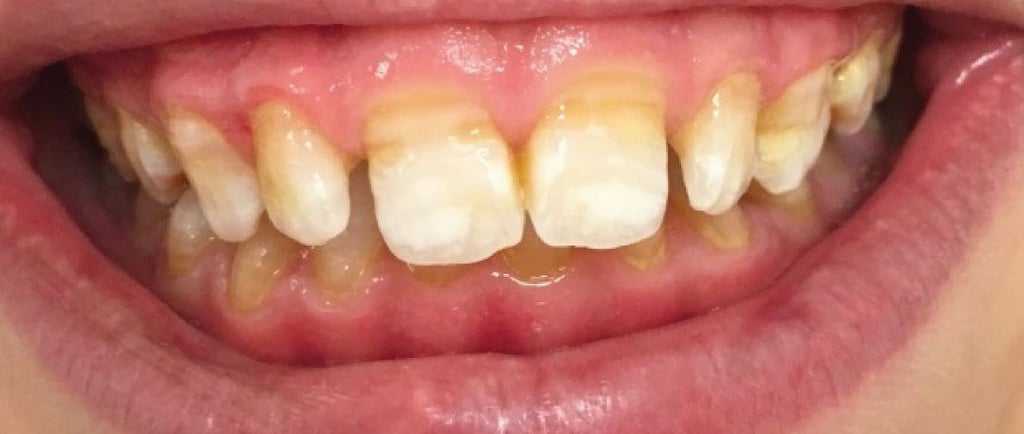SMILE- It costs nothing !!!
Causes and Treatments for Enamel Hypoplasia
Discover the causes and symptoms of enamel hypoplasia, a dental condition affecting tooth enamel. Learn about effective treatment options to ensure proper care and management for healthy teeth.
11/2/2024
Enamel Hypoplasia
Enamel hypoplasia is a dental condition that results in the inadequate formation of enamel, the hard outer layer of the teeth.
People with enamel hypoplasia often experience increased tooth sensitivity, discoloration, and, in severe cases, susceptibility to cavities and damage.
What is Enamel Hypoplasia?
Enamel hypoplasia is a developmental defect where tooth enamel fails to form properly during early tooth development.
Unlike other dental issues that may only affect the appearance or feel of the teeth, enamel hypoplasia affects the actual structure of the enamel, often leading to weak spots or grooves.
This structural weakness can increase the risk of cavities and wear, making enamel hypoplasia a condition that often requires long-term management.
Related : Why is your teeth discolored after trauma
Causes of Enamel Hypoplasia
Enamel hypoplasia can have a range of causes, often classified into two main categories: environmental factors and genetic influences.
1. Environmental Factors
Environmental causes typically involve external factors that affect a child’s health during tooth development, such as:
Prenatal Factors: Maternal infections, malnutrition, or certain medications taken during pregnancy can interfere with tooth development in utero, leading to enamel hypoplasia in a baby’s primary teeth.
Childhood Illnesses: High fevers, severe infections, or diseases like chickenpox, measles, and respiratory illnesses during early childhood can disrupt enamel formation. Some medications used to treat these conditions may also influence enamel health.
Nutritional Deficiencies: Deficiencies in essential vitamins, particularly vitamins A, C, D, and calcium, can impair enamel development, increasing the risk of hypoplasia.
Fluoride Overexposure: Excessive fluoride during early childhood can cause a condition called dental fluorosis, leading to mottled or thin enamel. While this differs from enamel hypoplasia, the symptoms may overlap.
2. Genetic Factors
Genetic conditions may also lead to enamel hypoplasia:
Amelogenesis Imperfecta: This hereditary condition affects enamel development, resulting in thin, weak enamel that is more prone to wear, sensitivity, and discoloration.
Inherited Disorders: Certain genetic conditions, such as Down syndrome or hypoparathyroidism, can impair enamel development, leading to hypoplasia.
Symptoms of Enamel Hypoplasia
The symptoms of enamel hypoplasia can vary widely depending on the severity of the condition. Common symptoms include:
Tooth Discoloration: The affected areas may appear yellow, brown, or white due to a lack of enamel thickness, making the dentin beneath more visible.
Surface Irregularities: Teeth with enamel hypoplasia may have pits, grooves, or rough patches that are visible or can be felt when touching the surface.
Increased Sensitivity: Due to the thin or missing enamel layer, affected teeth can be highly sensitive to hot, cold, sweet, or acidic foods and beverages.
High Risk of Cavities: Because the enamel layer is underdeveloped, teeth are more prone to decay, leading to more frequent and severe cavities.
Related : Understanding tooth decay
Diagnosing Enamel Hypoplasia
Dentists can usually diagnose enamel hypoplasia during a routine examination, often supported by dental X-rays that help to assess the thickness of the enamel and the presence of any structural irregularities.
The diagnosis often involves evaluating factors such as medical history, developmental history, and any visible enamel abnormalities.
Treatment Options for Enamel Hypoplasia
Treating enamel hypoplasia depends on the severity of the condition. Here are common approaches:
1. Fluoride Treatments
For mild cases, professional fluoride treatments can help strengthen the remaining enamel, making teeth more resistant to decay.
2. Dental Sealants
Dental sealants are a protective coating applied to the surface of the teeth, especially back molars, to guard against decay. They can be especially helpful for children with enamel hypoplasia to protect vulnerable teeth.
3. Composite Bonding
For more noticeable surface irregularities or discoloration, composite bonding may be used to fill in pits and smooth the surface. This treatment also helps protect the underlying dentin from decay and wear.
4. Crowns
In severe cases, dentists may recommend crowns to cover and protect the affected teeth fully. Crowns not only improve the appearance but also help protect the tooth structure and prevent further damage.
5. Porcelain Veneers
For front teeth affected by enamel hypoplasia, veneers are a common cosmetic treatment option. They cover the front surface of the tooth, masking discoloration and providing additional strength.
Managing Enamel Hypoplasia at Home
For individuals with enamel hypoplasia, taking extra steps to maintain oral hygiene is crucial:
Use Sensitivity Toothpaste: Specialized toothpastes for sensitivity can help reduce discomfort, especially for those with thin enamel layers.
Soft-Bristled Toothbrush: A soft-bristled toothbrush helps minimize wear on weak enamel surfaces.
Fluoride Mouthwash: Daily use of a fluoride mouthwash can help strengthen enamel and protect against decay.
Enamel hypoplasia is a manageable but lifelong condition that requires special attention to oral health.
Regular dental visits are essential for monitoring enamel health and for receiving tailored treatments to maintain a healthy and confident smile.

Contact Smiles
drdeepi15@gmail.com
Dr. Deepika B.D.S
© 2025 SmileWide Dental. All Rights Reserved.
Have doubts ..?


